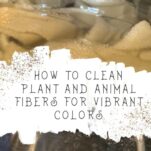This post contains affiliate links. I could be an affiliate for many different products, but I chose these specifically because they are the products and brands I like and recommend. By using my links, you help support this website.
The art of natural dyeing is a never-ending journey into the world of colors derived from nature.
However, before diving into natural dyes, there’s a crucial step for achieving the best results: scouring fibers.
Scouring, the process of cleaning fibers, is essential to remove any impurities and prepare the fibers to absorb dyes effectively.
In this blog post, we will expand on the key steps and tips from the video, providing you with a written roadmap for effectively scouring plant and animal fibers.

Scouring cellulose fibers
When it comes to natural dyeing, preparing cellulose fibers, which include materials like cotton and linen, is a critical first step.
Scouring plant fibers ensures that they are clean and ready to absorb dyes effectively.
Check out the companion video for a comprehensive guide on how to scour plant and animal fibers.
Materials needed for cotton and linen scouring:
To begin, you will need some materials.
The primary agent for scouring cellulose fibers is soda ash.
It’s a powdery substance, so wearing a dust mask is advisable to protect your lungs.
You’ll also need a kitchen scale, a jar with a bit of water, a kettle for boiling water, a suitable pot for the fibers, a bowl for weighing, and a small container for the soda ash.
- Soda ash in a container for easy access
- Dust mask
- Kitchen scale
- Jar
- Water
- Kettle or pot for boiling water
- A pot to hold the fiber
- A bowl for weighing out ingredients

Preparation steps for scouring:
Step 1:
The first step is to prepare the soda ash solution.
Start by measuring the weight of your fabric using the kitchen scale.
This measurement is crucial as it determines the amount of soda ash you’ll need.
The general rule of thumb is to use one to two percent of the weight of the fiber in soda ash.
For instance, if you have eight ounces of fiber, you need about 0.08 to 0.16 ounces of soda ash.
We made a simple soda ash calculator for you, so you don’t have to do the math! This calculator uses the 0.08 calculation amount.
Soda Ash to Cellulose Fiber Calculator
Dissolve the soda ash in a little bit of water in your jar.
It's recommended to boil some water and mix it with the soda ash to ensure it dissolves completely.
Remember to wear your dust mask during this process to avoid inhaling the powder.
The scouring process explained:
Step 2:
Once your soda ash solution is ready, pour it into a pot filled with room-temperature water. The pot should be large enough to allow the fabric to move freely.
The purpose of scouring is to remove any oils, grease, or sizing from the fibers.
This step is crucial so the fibers can fully absorb the mordant and the natural dyes later.
Place your fabric in the pot, fully submerged. It should have enough room to move around.
Heat the pot to 180 degrees F and maintain this temperature for about 30 minutes, stirring occasionally.
This process allows the soda ash to work, removing all impurities from the fibers.
After scouring, allow the fibers to cool down before handling them.
Step 3:
Once cool, rinse the fibers in water that's the same temperature as the scouring bath to prevent shocking the fibers.
This step is essential to be sure the fibers are thoroughly cleaned and ready for the next steps in the dyeing process.
By following these three steps, your cellulose fibers will be prepped for natural dyeing, capable of absorbing the most vibrant colors and ensuring long-lasting results.
Scouring protein fibers
Moving from plant-based cellulose fibers to protein fibers, such as those from animals like wool, silk, alpaca, and camel, the scouring process takes a slightly different turn.
Protein fibers require a different approach.
Check out the companion video for a comprehensive guide on how to scour plant and animal fibers.
Materials needed for protein fibers:
The key ingredient for scouring protein fibers is Synthrapol, a specialized detergent designed for this purpose. Alternatively, you can use a product called Power Scour. Use the same amount per weight of fiber.
Alongside Synthrapol, you'll need similar equipment as with cellulose fibers: a kitchen scale for accurate measurement, a pot large enough for the fibers, a stirring spoon, and a heat source like a hot plate or stovetop.
It's also helpful to have a jar with some water, a small jar for measuring the Synthrapol, and a towel for spills.
- Synthrapol or Power Scour
- Kitchen scale
- Pot for fibers
- Stirring spoon
- Water
- A jar
- Measuring tool for Synthrapol

Calculating fiber weight for scouring:
Step 1:
The process begins with calculating the weight of your protein fibers.
The fiber weight determines the amount of Synthrapol needed.
For commercially prepared fibers, the recommended amount is 0.5 to 1 percent of Synthrapol based on the weight of the fiber.
For example, for eight ounces of fiber, you would need about 0.04 to 0.08 ounces of Synthrapol.
And here's another calculator to help you. This calculation uses the 0.5% amount of Syntrhapol.
Synthrapol for Animal Fiber Calculator
Step-by-Step scouring method:
Step 2:
Once you have your measurements, dissolve the Synthrapol in a jar of water. Adding some boiling water can help the detergent dissolve more effectively.
Pour this mixture into a pot of room-temperature water, large enough to accommodate your fibers with room to move.
Place your protein fibers in the pot, ensuring they are fully submerged and can move freely. This guarantees that all parts of the fiber come into contact with the Synthrapol solution.
Heat the pot to 180 degrees F and maintain this temperature for 30 minutes. It's important to stir the fibers occasionally during this process to ensure even scouring.
After the scouring time is complete, allow the pot to cool until it's safe to handle the fibers.
Step 3:
Using gloves, remove the fibers from the bath, gently squeezing out excess water. Rinse the fibers in water at the same temperature as the scouring bath to avoid temperature shock.

Post-scouring tips for animal fibers:
Once you're done, the bath can be safely disposed of down the drain or used in flower beds, adhering to eco-friendly practices.
Following these 3 steps, your protein fibers will be thoroughly scoured and ready to absorb the beautiful colors from natural dyes.
Post-scouring tips for plant and animal fibers
Handling and storing scoured fibers:
If you're not planning to dye the fibers immediately after scouring, you have a couple of options for storage.
For short-term storage, you can keep the wet, scoured fibers in a refrigerator for three to five days.
Place them in a Ziploc bag to maintain their moisture. This method is particularly useful if you plan to mordant the fibers soon after.
It is advisable to mordant your fibers within 5 days of scouring. If the fibers are stored in a Ziplock bag in the refrigerator, they will not mildew in this timeframe, and they will remain clean.
Any longer, and you run the risk of mildew occurring. If stored dry, the fiber may become dirty again simply through the oils on your hands or dirt or dust in storage.
Environmental considerations in scouring:
An important aspect of natural dyeing is its eco-friendliness.
When disposing of the water used in the scouring process, be sure it's cooled down.
The water from scouring cellulose fibers containing soda ash can be safely poured down the drain.
Alternatively, it can be used in flower beds, as soda ash can benefit some plants (use at your discretion).
The water containing Synthrapol can also be disposed of down the drain for protein fibers. However, as with any detergent, it's important to be mindful of the quantity and frequency of disposal, especially if you have a septic system or are concerned about the environmental impact.
By following these post-scouring care and environmental tips, you ensure the best results for your natural dyeing projects and contribute to sustainable and eco-friendly practices.

Enhancing your natural dyeing results
Scouring is foundational for the vibrant and lasting colors we all strive for in our dyeing projects.
Whether working with cellulose fibers like cotton and linen or protein fibers like wool and silk, the scouring process is your first step towards achieving a successful natural dyeing outcome.
Remember, natural dyeing is not just a craft; it's an art form that connects us to the ancient traditions of textile creation while allowing us to explore sustainable and eco-friendly practices.
Happy dyeing!












